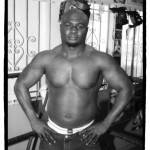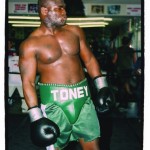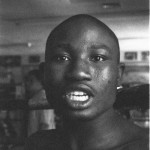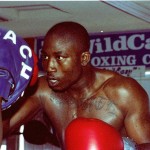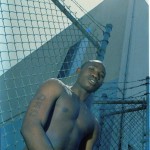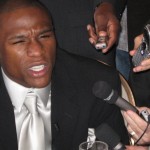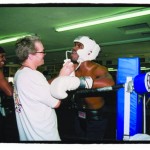Wild Card Boxing Gym
Bring on the Lions
WILD CARD BOXING GYM
by Carlos Batts
Rocky III is my favorite movie in the series. It’s about gluttony. Rocky gets his ass kicked because he has everything. And here comes Clubber Lang, played by Mr. T. He comes from nothing, he’s hungry, and he kicks Rocky’s ass. That, to me, epitomizes what boxing is all about. It’s not about money or fame or glory. It’s about discipline, and your desire to win.
As a photographer, I’ve worked in the world of gothic and porn. Ever since I moved to Hollywood six years ago, I’ve been shooting celebrities. Even in my commercial work, I have always tried to be an artist. Over the years, I have done a lot of work that has challenged me. I’ve done a lot of work I am proud of. But I have to confess: somewhere along the line, I had lost a little bit of that white-hot spark that drove me to this profession.
When I walked into the Wild Card Boxing Club for the first time in June 2001, I rediscovered my spark. As soon as I entered that door off of Vine Street, I was steeped in the gym’s international, worldly feeling. Boxers from all over the world come to Wild Card to train. Ola Afolabi, an up-and-coming cruiserweight fighter who has a near perfect record, is of Nigerian descent, from the U.K. Kahren Harutyunyan, the North American Boxing Organization Bantamweight Champion, is an immigrant from Armenia.
Former championship contender and legendary trainer Freddie Roach is the owner and patriarch of this gym. Under his watch, Wild Card has become a home away from home for countless fighters and weekend warriors alike.
Steve Kim, a reporter for Maxboxing.com, is a dedicated client of Wild Card. “Freddie has a place with a lot of atmosphere. There’s a sense of security, there’s a sense of community. If you put your gym bag down, you don’t have to worry about it getting stolen,” he says. “The talent level is unmatched. This gym, per square feet, has more world class fighters and true prospects than any other gym by far.”
Before major fights, Wild Card often hosts press and fans in “open workouts.” These days are particularly exciting times to visit the gym. It’s almost like a show. Celebrities and media people buzz around the ring. The energy around the ring is kicked up a notch. The place becomes a contained spectacle.
The first time I visited the gym, it happened to be during one of these “shows.” I walked in, and instantly felt that there was a deep, relentless pulse to the place. The staccato repetition of fighters hitting speed bags; the slower bass of punches to heavy bags; evenly spaced grunts coming from boxers sparring in the ring – it was rhythmic and kinetic. Like the kind of pounding punk music that gets you riled up and excited.
I was intoxicated.
I took some pictures, and came back the very next day. Right away, I noticed the energy in the gym was different. The atmosphere was no less intoxicating, but things were toned down. Over the years, I have realized that Wild Card is like a living organism. Fighters move through their lives and change. As their weights and careers peak and fall, the atmosphere in the gym transforms with them. The more I visited the gym, the more I felt poignancy for these fighters who gave their mind, body and soul to boxing.
In Hollywood, the entertainment business is the local industry, just like how in parts of Kentucky, coal mining is the local industry. Maybe sometimes, people in the “biz” just want to be treated like any other working stiff. Maybe sometimes, people in the “biz” just want to feel like regular Joes. For these people, Wild Card is the place to go.
Macka Foley, former pro fighter and current trainer at Wild Card says, “We make most of our money off actors. We treat them just like fighters. We train them like they’re going to be fighters.”
Wild Card hosts a diverse clientele – financially and ethnically. You can see big shot Hollywood types sparring next to penniless fighters from East L.A. This being Hollywood, there is a definite celebrity aspect to the gym. Mario Lopez of Saved By the Bell comes in virtually every day. But everybody is united under one cause: boxing.
Lets meditate for a moment on the meaning of boxing. There is no other sport like it. There is no faking it in the boxing gym. You can’t hide behind your teammates. You can’t hide behind your “image.” It’s just you. It’s about how you handle yourself in the heat of the moment. Grace under pressure. It’s not just about brute strength, it’s about your mental and emotional stamina.
It wasn’t just muscle and technique that allowed Sugar Ray Leonard to come out of semi-retirement to beat Marvin Hagler in a controversial split verdict. What gave Muhammad Ali the edge in his fight against George Foreman in Zaire was his confidence, his energy, his passion.
26-year-old Ola Afolabi has had 11 wins, one loss, and three draws in his short career. A native of the U.K., he moved to California specifically to seek out Freddie Roach. Sitting on stairs outside the gym, he says observing the “best fighters in the world” at Wild Card “made me what I am today.”
Boxing has always been the sport of underdogs. The boxing ring has always been the one arena where ethnic minorities can rise up and become contenders. In the turn of the 20th century, there was a wave of prominent Jewish boxers. 1920’s lightweight champion Benny Leonard, AKA the “Ghetto Wizard” grew up in the immigrant neighborhood of New York’s Lower East Side. When the Italian and Irish immigration wave hit the U.S. around the same time, the boxing scene overflowed with world class Italian-American and Irish-American fighters like multi-division title winner Tony Canzoneri and “Cinderella Man” James Braddock.
The historic integrated fight between Jack Johnson, the first black heavyweight champion, and the “Great White Hope” Jim Jeffreis in 1920 sparked riots and unprecedented press coverage. (Ebony magazine cited a quote from an Indianapolis Freeman article from that era that said “Perhaps no other event has held so universally the gaze of mankind.”)
In the U.S., battles of ethnic assimilation and have historically been fought in the boxing ring. There is a reason for this. People often say, “death is the great equalizer,” but the same could be said about boxing. Inside the ring, money, status, and race go out the window.
If boxing is the great equalizer, the Wild Card Boxing Club Boxing Club offers the ultimate equalizing playing field. An unassuming bespectacled fellow, Freddie Roach keeps the atmosphere in his gym “real.” When I say “real,” I mean he will approach you in exactly the same way as he will approach Mike Tyson. He doesn’t take any bullshit, and he doesn’t give any either. In his gym, everybody is equal. Roach is un-phased by flash and ostentation. On a message forum interview conducted on Maxboxing.com, he said, “I would rather have the work ethic with mediocre talent.”
Named 2003’s “Trainer of the Year” by the Boxing Writers’ Association of America, Roach has trained some of the most eminent boxers in recent memory. Mike Tyson, James “Lights Out” Toney, and former heavyweight champion Michael Moore have all toiled under Roach’s direction. Walk into Wild Card any day of the week and rest assured you will witness the next generation of world-class boxers at work. Manny Pacquiao, a Filipino Super Featherweight Champion is a recent prodigy of the gym.
Afolabi: “[Freddie] doesn’t watch you alone in the ring. He watches your opponent, and he watches for his flaws. When you come back to the corner, he doesn’t shout. He doesn’t raise his voice. He just tells you what to do to dissect your opponent. You do it, and it will happen. He’s like a professor of boxing.”
Wild Card gym is in the heart of Hollywood, near the corner of Santa Monica and Vine, just south of Sunset Blvd. Freddie Roach grew up in a working-class Boston town, but he makes Los Angeles his home. He is regularly interviewed in all media outlets. His gym plays host to celebrities and star athletes alike. In Hollywood, Roach is on the inside. And maybe he, more than most, understands the sacrifice and discipline that is at the heart of all the glamour.
There were moments when I was mesmerized by the scenes unfolding in the gym. There were days when you could see the history of boxing unfold before your eyes. Champions from the past and present convene together to spar in the ring. It was like watching an all-star band at work.
At other times, what I saw was heartrending. I watched James Toney, at the age of 34, mill his body from heavyweight to cruiserweight to fight and win the International Boxing Federation Championship. What it cost him mentally and physically, to get that title, I can only guess. The pressure, the focus, the sheer hunger of a world-class fighter is an awe-inspiring thing.
Photographs from before the digital boom of the 1980’s have a special poignancy to me. Maybe it’s just nostalgia, but things were simpler back then. No touch-ups, no digital scanning. The photographic image was pure. As a photographer, it was all about what you were able to capture in a key moment. You had to be like gunslingers – quick on the draw, always on the ball.
I guess what I see at Wild Card gym, is this kind of purity. Under Freddie and his staff’s training, the fighters are always primed and on point. In a town that runs on “image” and the illusionary screen of celebrity, Freddie’s Hollywood gym runs on solid work and discipline.
I come to Wild Card for this sobering shot of reality. At least once a month, I cruise through with my camera. I hold brief conversations with the trainers, fighters, and clients. Sometimes the fighters would let me take their picture. But I always keep it brief. (At Wild Card, I’m acutely aware of being an observer, not a contender). These regular visits un-clutter my mind, and energize me. Maybe it’s kind of like going to church. Freddie’s gym – for me, and for so many others – keeps my feet on the ground.
Justin Fortune is a former heavyweight fighter, who fought Lennox Lewis in 1995 for the world title. Today, he is Freddie’s assistant, and works at Wild Card as a trainer. He speaks with the same swift directness that defined his fighting style when he says: “This is a hardcore, old school gym. We train to fight, and that’s exactly what we do. We train fighters to fight. Not to pussy foot around.”


